Saturday night, 9/11/04, I had my first observing field trip. Every near-new-moon Saturday, the Coconino Astronomical Society has standing arrangements for observing at some sites around Flagstaff, weather permitting. I got in touch with Bill Ferris (the CAS point man) to see what the latest arrangements were. We ended up meeting at a place southeast of town, Anderson Mesa, where Lowell Observatory has a satellite observatory in actual dark-sky country--as opposed to the historic site that sits right against the downtown lights.
It was about 15 minutes after twilight when we got there, and I was stressing out that I we were going to blow out people's night vision when we pulled up. Fortunately Bill was the only one there, and he was still setting up. I later learned that the road gets a few cars a night with people driving up to the observatory, and hunters spying out the territory, and you just scrinch your eyes shut when you hear the telltale sounds around the bend.
This was my first mobile setup of the telescope, and it went remarkably well. I had followed some advice from Tom W. at the Cloudy Nights forum, and picked up a large rubbermaid tub and some foam to transport the mount, weights, spreader, and my doodad case. It worked like a charm. Since I don't have a carrier for the OTA, I rolled it up in a big fluffy comforter enchilada-style, and packed it firmly in the trunk. It seemed to work pretty well as a transportation method for the time being.
As I was setting up the tripod and the mount, this reeking manurey scent kept wafting over me. After a few bouts of gagging, and trying to convince myself it wasn't me I was smelling, I finally broke away to do a red-light survey of the grounds. Turns out I had parked the car so that both driver & passenger doors were squarely over two fresh piles of horse manure. So, there's reason number 2 (heh) to arrive *before* sundown. Seeing's how I had already leveled the scope and started my polar alignment, I decided to live with my spot, and just warn Amanda & the kids about the minefield locations.
As I was finishing the setup, Bill asked if I had seen M13 yet, so I went over for a look through his 10" pier-mounted Newtonian. What a sight. I've seen images of globulars where I felt people had oversharpened to bring out the foreground stars, but after seeing it at that aperture, I can say that the brighter foreground stars actually pop out from the core almost as if they do have a USM halo around them. It was a very sweet view. At this point, I marked up my next wish list item as Bill pointed out M13's location with his green laserpointer. I mean, it is definitely cool in its own right, but what a useful tool. It got a lot of use that night pointing out constellation boundaries and DSO positions that helped me nail down locations to turn the scope to.
So my first view through the 6LT with a 25 mm eyepiece that night was M13, which compared well with what I saw through Bill's scope, although obviously less resolved. I could still pick out decent granularity and a hint of spokes from brighter stars trailing away from the core. Yonder in the distance, a pack of coyotes yapped high-pitched giggles at each other. It was a nice indication of how far off the beaten path we were.
After reading some discussions about the difficulty of finding M33, I decided to swing over and give the Triangulum Galaxy a try. By this point, Bill's observing buddy, Brent Archinal, had showed up, and he used the Green Laser of Navigation to mark out the boundary of Triangulum, and then M33's position relative to it. Awesome. That image is burned into my mind. I'll never forget how to find it. I couldn't make it out by naked eye yet, but through the finder scope, it showed as dim smudge comparable to what M31 looks like naked eye. I centered on that, and through the eyepiece I could make out the elongated core. Looking at it long enough, I thought I could see some variation in density outside the core that might indicate one of the arms, but I'm not positive. On another night when I'm not so giddy to see anything and everything from a dark spot, I want to spend more time on it.
But Sagittarius was heading inexorably westward, and I didn't want to miss that opportunity. So after a brief stop at M57, I took some time for a naked eye view of the teapot. I can't emphasize enough what a really dark sky does for naked eye observing. I could make out nebulas and clots of stars all over the place in Sagittarius. It was like a dozen signs saying Look Here! Look Here! So I aimed for the brightest knot and took a look. What unfolded for me was a beauty of a nebula, folded like wrinkled velvet around a cluster of brilliant stars. As this was an unplanned segment of my tour, I cheated and asked for some help identifying it. Brent took a look and pegged it as the Lagoon Nebula, M8. Bill came over and put in his OIII filter so I could see the difference. It really popped out the lines of the nebula. So onto the wishlist it goes...a wee bit further down the line after the UltraBlock.
I scanned a couple doors down and picked up my next nebula, M20, the Trifid. It was much dimmer compared to M8, but with averted vision, I could make out the spokes in the emission nebula. At this point, Brent suggested I remove the OIII filter to see if I could pick up the adjoining reflection nebula. And sure enough, there it was, not as well defined, but still apparent. I obviously didn't pick up color in either one, but we had a discussion about how one can deduce the color based on what shows up with and without a filter. Bill also pointed out that I should actually be able to resolve the center star into 2 stars with my telescope. But people often don't expect that at first since most astro photos blow out the stars to emphasize the nebulosity. With the 10 mm eyepiece in place, I could easily make out 2 stars. Most excellent. I wouldn't have thought to look for that. And so, M20 and M8 went on the list for further observation very soon.
I took a little break here to go look at what Bill had pulled up in his scope. A piece of the Veil Nebula. I was very surprised at how well defined the knots, streamers and twirls showed up. My daughter saw it easily, and described it as a little Milky Way. Which is how she tends to see the soft-and-fuzzies right now. By this time, my family was getting tired, so I got the kids loaded up, said good night to Amanda and watched as they drove off. We brought 2 cars you see. Because we knew I wouldn't be able to pack it in at a decent hour ;-)
My next 2 stops above Sagittarius were the Swan (M17) and Eagle (M16) nebulas. I needed help identifying these as well. I'm not saying I couldn't have done it myself with a little star chart comparisons :-), but it's so easy when you have a couple seasoned veterans hanging around. My first impression of M17 was of a straight brush stroke. With longer observation, and a little help from hearing it was the "swan" nebula, I could make out the loop at one end. M16's most striking element was the star cluster. The nebula played tenth fiddle to those stars through my telescope. I found it hard to resolve, and with some help, I could eventually see a darker intrusion in the nebula that houses the famous Pillars of Creation. This is something I would really like to see in a larger telescope someday.
At this point, Bill and Brent were discussing NGC7293, The Helix Nebula, that they had pulled up in his scope, and how it didn't seem to be resolving so well, with some discussion about humidity, and high thin clouds possibly tampering with contrast. Before taking a look, I asked for some help locating it, and managed to pull it up without too much trouble. It resolved to a large circular nebula with a hollow core. Picking out more detail would have taken some time, but I wanted to see it in the 10" for comparison. I was surprised that it didn't look too much better there. I'm not sure why. Although it might have been an issue of low Oxygen after a recent waft of horse dookie.
After grabbing a little Pepsi pick-me-up, I went over to see the next field Bill had pulled up. It was Stephan's Quintet. This was a real test of vision for me. After some concentration, and deep breaths, I could start to make out what seemed like 4 very faint shapes framed in the eyepiece. There was a central patch, and then at 12 o'clock and 10 o'clock another two shapes, and finally a very elusive one around 6:30. After looking up a picture today, I can see that the central shape was the double-galaxy Bill mentioned. For as indistinct of a view as it was, it was very exciting that I actually saw it, sketched the positions, and then had them match up to a picture the next day. I think that would be a true test of my 6LT, if I could someday hunt the Quintet down myself.
The last thing I checked out before Bill and Brent took off for the night was the coathanger asterism. I checked it out through their binoculars first, and it really is very striking. Much moreso than pictures I've seen up to this point.
As Bill was packing up to leave, we talked about the Coconino Astronomical Society, and some folks with some gnarly observatories that are eager to share the views with new members. (ooh! me me me!) And so we shook hands and he took off, still never having seen his face. What an incredibly helpful guy.
But I had to stay. There were a lot of pictures I wanted to take. A couple of which didn't turn out half bad. I really wanted to work on my focus. And I think spending more time on that yielded visible improvement in what I was able to shoot. The Hartmann mask wasn't doing it for me. There was too much play in the area where the circles merge to be of any real help to me. So I just started doing test exposures and tweaking focus one direction or the other until I got as much improvement as I could stand to tweak for. I know I can do better, but it's probably going to take some expensive technology...or simply a couple hours finessing focus every time to get me there.
I decided to start my photography adventures with some piggyback shots using my Canon Digital Rebel (with ruby-lith taped over the LCD display for easiness on the eye). The first shot I took was of the Milky Way star field along Cygnus which by this time was flying into the western horizon. I spent about 15-20 minutes testing exposures to fine tune my focus. The nice thing about the Rebel is I can zoom in very tightly on a star after making the exposure to see how I'm doing with focus. And then take a deep breath, form the void of concentration in my mind, softly touch the focus ring and apply the slightest pressure that will twist the ring a half a hair. Expose again and see how it looks, all the time repeating 'clockwise clockwise clockwise' in my head to remember the direction I was twisting on the last adjustment. Once I had the focus as good as I was willing to frustrate with, I started a series of 3 6-minute exposures with the kit lens zoomed to 55 mm and the aperture opened to f/5.6. A couple minutes into the third exposure, a soft buzzing directed my attention to a low flying plane coming in from the east, riding the Milky Way like it was a bowling alley, and Cygnus was the pins. So with some hissing between my teeth, I cut that exposure short at 3 minutes, just before the plane entered the shot. I probably should have taken another shot to make up for it, but there was so much more I wanted to get to, and the night only lasts so long you see.
Here's what I got after subtracting dark frames, making a digital flat field, stacking, and adjusting curves.

Large Size (757K)
Medium Size (202K)
By now, Orion was well above the horizon, so I twisted around and framed it. My focus was already set from Cygnus, so I just started shooting more 6-minute exposures. About a minute into the second exposure, a rustling noise caught my attention. "Pepe!" I thought, as I slowly backed away and fumbled for my red flashlight. As I swept the light through the grass and bushes, I saw the dreaded fluffy, black and white tail scuffling around. If you think that skunks will scurry away at the sound of frightened humanity, you are wrong. They've got the guns and they know it. So after hollering and stamping my feet and waving the flashlight menacingly, I hopped in the car and watched as it approached my setup and sniffed around. By this time, I thought to heck with night vision and removed the red filter. Now it's beady little close-set eyes got a nice green glare to them as it stood up and sniffed in my direction. It must've finally got hit by the emanations of the manure field, because it turned back around and started hobbling back into the brush. I had lost track of my 6 minute count a couple times there, so I estimated where I was in the stream of time and crept back out to shut down the exposure. One more exposure, and I was done. Here's the results of those shots:
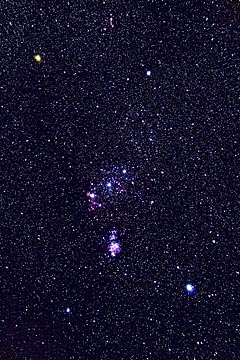
Large Size (555K)
Medium Size (129K)
As if to reassure me that stink-varmits aren't the only things roaming around, distant echoes of elk trumpeted like land-whales, while the coyotes howled and yapped at intervals. But I couldn't stop craning to hear the rustling of Le Pew...and then my imagination being the way that it is, I started wondering about cougars and bears. I'd hate to get tackled by a cougar or charged by a bear. I made mental plans of how to pirouette around the telescope as a shield and then dive for the car if I had enough warning of an advancing carnivore or confused omnivore. As I tamped down my predator/prey fears, I moved on to the Pleiades and had some marginal success. In an effort to bump up contrast on the main stars and bring out the nebulosity, I got a lot of oversaturated color halos around the brightest stars. This is one I'll need to work on some more another time.
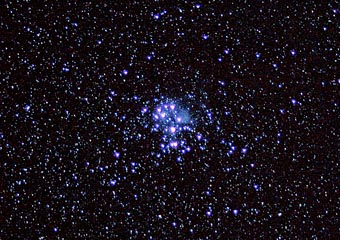
Large Size (340K)
Medium Size (136K)
I decided that was enough of the piggybacks, and moved on to some eyepiece projection shots. I had to start the focusing game over again, but this time with the telescope rack & pinion focuser. I started with multiple 20 second exposures of the NGC 884 portion of the Double Cluster in Perseus. In order to capture them both in one frame, I'd need to figure out a way to get prime focus to work. Bill suggested that a low-profile focuser might get me there. At some point, I'll get around to removing the focuser and manually pointing the camera to see if there's any chance of prime focus working with a different focuser. As it is, my Double Cluster image shows quite a bit of coma around the edges of the frame. Bummer. I'd have to do a mosaic to get a nice image of this one. Also noted for improvement are focus and tracking. 20 seconds was was about as good as I could do without star trails forming. I know I can get more out of the SVP mount, but that's going to require more attention to camera balance, learning drift alignment, and relubing and tightening up the mount. Here's the image:
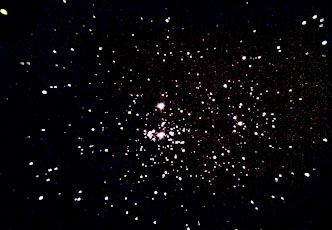
Next I moved on to M42 which was higher in the sky. Following is the result of the 12 best stacked 20 second exposures, with 3 60-second exposures that had some miraculous tracking success. For this image, I masked the 60-second frames to bring out the fainter dark foreground nebula while not blowing out the trapezium area. I'm not sure if this is considered cheating. I didn't paint anything. I just tried to do what might be considered dodge & burn style techniques that a darkroom technician might do to bring out faint details. I think that several more stacked exposures would help with removing grain from the nebulosity. Also the focus issue. Here it is:
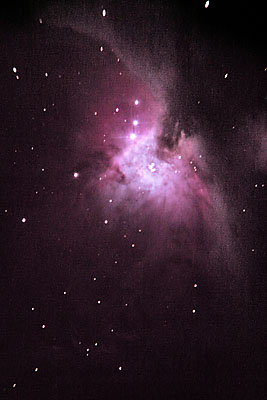
Large Size (128K)
Medium Size (55K)
As things progressed, I was anxiously keeping an eye on Saturn and Venus rising in the sky. And so now it was Saturn's turn to get some attention. One of the things I forgot to mention is that I was using the hat trick to minimize vibration blurring from mirror slap on the previous 2 shots. With Saturn, it was an even bigger concern. I only needed about a second worth of exposure per image. And hat-tricking a second-long exposure is weird. I used my black notebook to pull away and cover back up in as quick of movements as I could. The result was a couple dozen images that varied greatly in brightness. So I used curves to get them all to about the same brightness before stacking them. I picked the 15 best images to stack, and this is the result:

Same thing for Venus. But I'm not seeing much improvement since the last time I shot it. Fooey. I think I'm going to break down and load the hacked firmware on the Rebel so I can get mirror lockup.
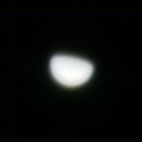
Okay, so the moon looked really cool as it rose above the trees. So I took the camera off for a bit to get some good eyepiece views. Observing that hauntingly thin crescent through the eyepiece, I kept imagining that I should see the Nostromo come cruising out of the brightening dawn across the view. Definitely a sci-fi view.
I backed away for a minute and imagined a line from Saturn to Venus and then to the horizon, where I saw a bright star rising that I wagered was Mercury. So I lined up the scope and saw that yep it was definitely a blurry disk. The red-blue refraction of the low horizon made it impossible to see a half disk that I knew it should be. But I put the camera back on and snapped some pictures. I realigned the red and blue channels to match the green channel on each image before stacking, but it still came out as a blurry disk. No phase. Bummer. I think next time, I'll let the telescope track it higher in the sky before shooting. (Finding it visually at that height would be too difficult I think, so finding it low and tracking high would be the way to go.) Here's good old Blurcury:
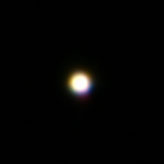
I couldn't let the moon off easily, so I grabbed my last shots:
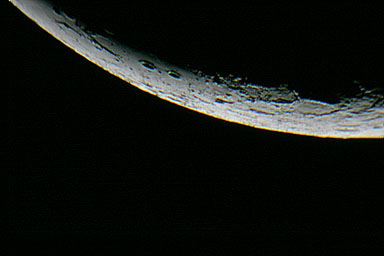
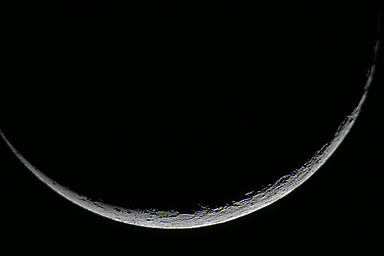
By the way, Pepe came back for a visit during the Saturn shots, but I was a lot more furious about scuffing my feet on the gravel, and he seemed to take that as an invitation to get lost this time. Doggone skunks. Maybe if I was more like Grizzly Adams, we'd just take a shine to each other, and play scratch-my-chin, and everybody's happy. But I think I need to be a bit more seasoned for that. Also rabies. Who wants rabies?
Anyway, that was my all-nighter. The elk and the coyotes shushed up as the sun rose. I got everything packed up and started meandering down the hill just as the hunters in their ATV's and full camo started chugging up the road. Maybe I should invest in an orange reflecto vest for the next excursion.
If you got all the way through this, you deserve a much-needed nap. Thanks for reading. :-D




